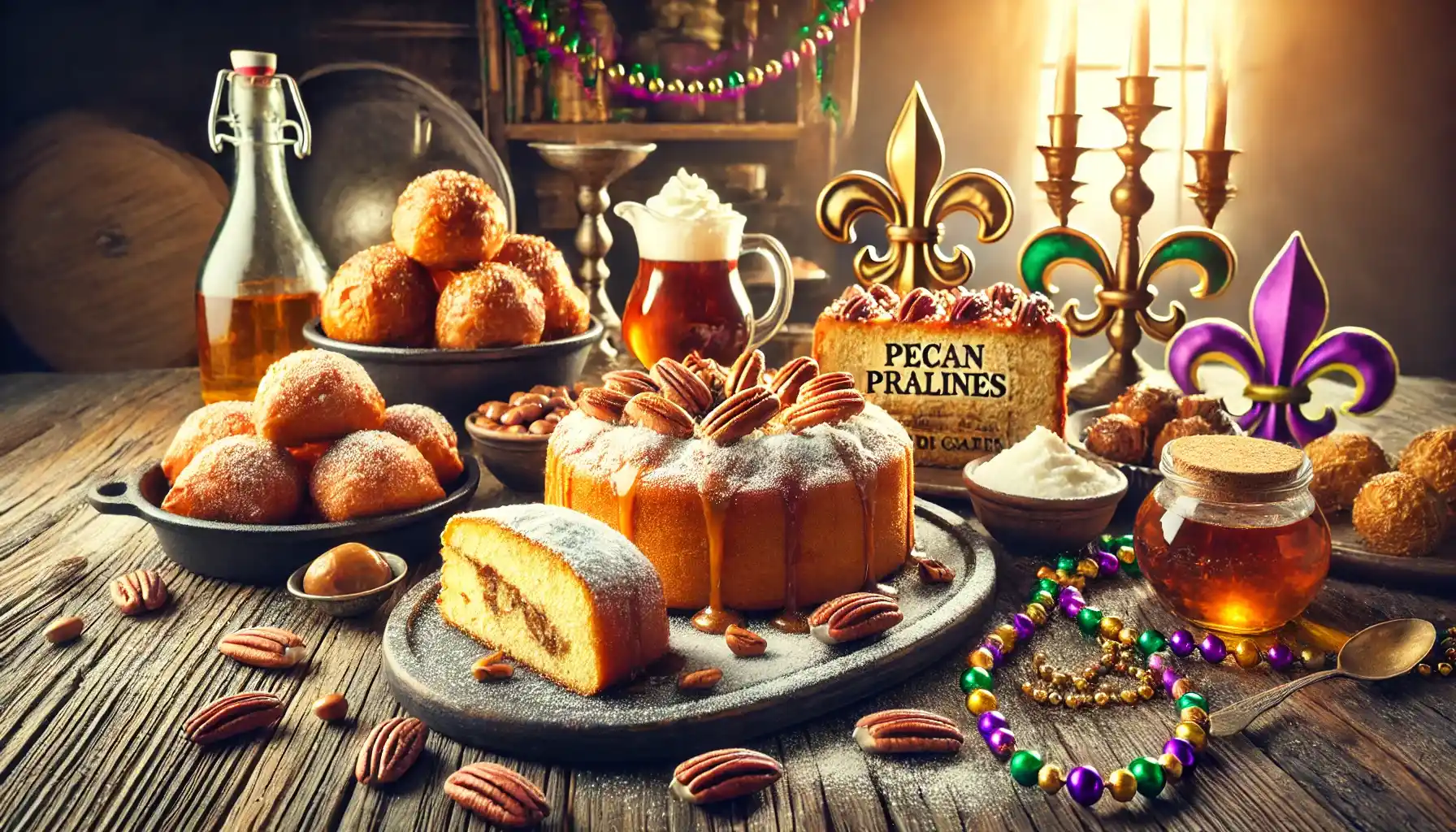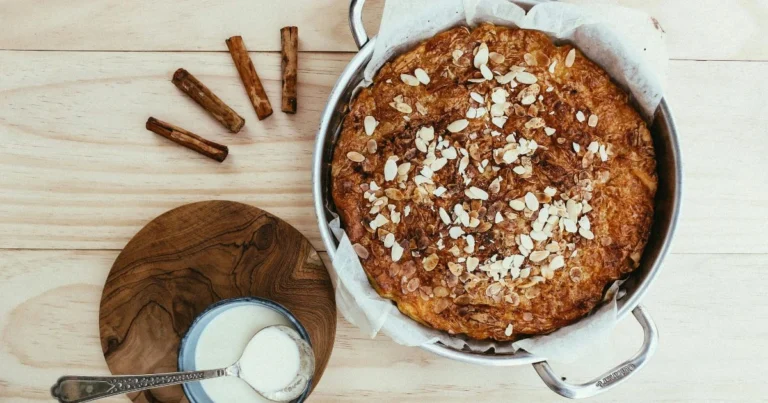Cajun Desserts: A Sweet Taste of Louisiana Heritage
Cajun cuisine is famous for its bold spices and hearty stews, but the realm of Cajun Desserts is equally enticing. Hailing from Louisiana’s bayous and marshlands, these sweets reflect a vibrant blend of French, African, and Native American influences. From sugar-dusted beignets to syrup-soaked bread puddings, Cajun treats showcase the region’s rich cultural tapestry, where food is more than sustenance—it’s a way of life.
Table of Contents
In this article, we’ll explore the backstory, key ingredients, and most-loved examples of Cajun Desserts. We’ll also connect them to other global sweet traditions, including Turkish Cuisine Desserts and an Egyptian Dessert Safari, which you can discover further as you broaden your knowledge of Global and Regional Desserts.
A Brief History of Cajun Desserts
Louisiana’s Cajun people trace their ancestry to the French Acadians who were exiled from Canada’s Maritime provinces (originally called Acadia) in the 18th century. Settling in the swamps and rural areas of Louisiana, these newcomers combined traditional French cooking techniques with readily available local ingredients—rice, sugarcane, pecans, and fruits like figs and peaches.
Over time, African and Native American cooking methods also shaped Cajun cuisine, adding layers of complexity to the flavors. Thus, Cajun Desserts emerged from a crossroads of cultural influences, adapted to the subtropical climate and the bountiful local produce.
Key Ingredients in Cajun Sweets
- Sugarcane and Molasses
Louisiana has a longstanding sugarcane farming tradition. Molasses, a byproduct of sugar processing, features in many Cajun sweets, adding a deep, caramel-like flavor. - Pecans
Pecans are native to the American South and appear frequently in Cajun desserts, lending a rich, nutty element. They’re often used in pralines, pies, and crumbles. - Eggs and Dairy
Creamy bases, such as those in bread pudding, rely on eggs and dairy for their indulgent texture. These ingredients also reflect the French influence in Cajun baking. - Spices (Cinnamon, Nutmeg, Cloves)
Even though Cajun cuisine is known for spicy, savory dishes, warm aromatic spices have found a home in dessert recipes. Cinnamon and nutmeg appear in breads, pies, and sweet sauces. - Locally Grown Fruits
Fruits like peaches, figs, and strawberries grow well in Louisiana’s humid climate. These fruits frequently make their way into cobblers, jams, and pies, adding a burst of freshness.
Common Techniques in Cajun Desserts
- Slow Cooking
Similar to the “low and slow” approach used in Cajun savory dishes, desserts such as bread pudding are often baked slowly, allowing flavors to meld and intensify. - Caramelizing
Cajun sweets frequently include caramelized sugars or syrups. This method produces a complex layer of sweetness and a hint of smokiness. - Deep-Frying
From beignets to fried fruit pies, deep-frying is a hallmark of Southern cooking. The crispy exterior and fluffy interior add a distinctive texture contrast. - Steeping Spices
Soaking or steeping sweet sauces with spices like cinnamon and nutmeg infuses them with warm, comforting aromas that underscore the dessert’s sweetness.
Five Iconic Cajun Desserts
1. King Cake
Traditionally associated with Mardi Gras, King Cake is a vibrant, ring-shaped pastry adorned with purple, green, and gold icing or sugar. Its slightly sweet dough is frequently flavored with cinnamon. Some bakers stuff the cake with cream cheese or fruit fillings. A small trinket (often a plastic baby) is hidden inside, and whoever finds it is considered lucky—or responsible for hosting the next party!
2. Bread Pudding
Bread pudding is a quintessential comfort food in Louisiana, made from day-old bread soaked in a custard blend of milk, eggs, sugar, and spices. Baked until golden, it’s usually crowned with a whiskey or rum sauce. The final result is a decadent, creamy dessert that’s perfect for chilly evenings or festive gatherings.
3. Pecan Pralines
Pralines in Louisiana differ from their European counterparts by replacing almonds with pecans. Sugar, butter, and cream are simmered until thick and caramel-like, then pecans are mixed in to form clusters on a parchment-lined tray. These melt-in-your-mouth confections offer a smooth, almost fudgy texture with a satisfying crunch from the nuts.
4. Beignets
Beignets are square-shaped doughnuts without holes, fried until puffed and golden. Heaps of powdered sugar dust their tops, creating a sweet, messy treat beloved by locals and tourists alike. Enjoyed best with a cup of strong café au lait, beignets are a must-try in New Orleans’ French Quarter.
5. Fig Cake
Figs flourish in Louisiana’s climate, making fig cake a prized family recipe in many Cajun households. The natural sweetness of the figs reduces the need for added sugar. Often spiced with cinnamon or allspice, fig cake embodies rustic Southern charm and pairs beautifully with vanilla ice cream.
Table: Popular Cajun Desserts at a Glance
Below is a quick reference table illustrating some main ingredients, flavor profiles, and unique notes of beloved Cajun Desserts.
| Dessert | Key Ingredients | Flavor Profile | Unique Notes |
|---|---|---|---|
| King Cake | Sweet dough, Cinnamon, Icing | Sweet, Spiced, Festive | Hidden trinket for Mardi Gras tradition |
| Bread Pudding | Bread, Milk, Eggs, Sugar | Rich, Creamy, Comforting | Often topped with whiskey or rum sauce |
| Pecan Pralines | Sugar, Butter, Cream, Pecans | Caramel-like, Nutty, Soft | Fudgy texture with crunchy pecan pieces |
| Beignets | Yeast dough, Powdered sugar | Light, Fluffy, Sugary | Served hot with café au lait |
| Fig Cake | Figs, Flour, Sugar, Spices | Fruity, Warm, Earthy | Uses fresh, local Louisiana figs |
How Cajun Desserts Fit into the Global Sweet Landscape
Similarities and Differences
Cajun desserts share certain elements with other regional sweets, especially regarding their use of syrup and rich spices. However, they stand out by showcasing local Louisiana produce and an unmistakable touch of Southern hospitality.
Comparing Cajun Desserts to Turkish Cuisine Desserts underscores how cultures worldwide rely on nuts, sweeteners, and pastries to create comforting dishes. But while baklava leans on phyllo dough, pecan pralines draw from Louisiana’s sugarcane and pecan wealth for a taste that’s purely Southern.
Cajun Food Desserts and Global Explorations
After sampling New Orleans’ bread pudding, you might be intrigued to try Egyptian treats on an Egyptian Dessert Safari, where dates and honey reign supreme. Likewise, exploring Turkish Cuisine Desserts can open your palate to rosewater-infused sweets like baklava and lokum. Together, these global dessert explorations paint a picture of how each region’s history, climate, and trade routes sculpt its beloved confections.
Tips for Enjoying Cajun Desserts
- Sip Something Strong
Pair sugary treats like pecan pralines or beignets with robust coffee or chicory coffee to balance the sweetness. - Watch for Seasonal Variations
Some desserts, like fig cake, depend on fresh produce. When figs are in season, try a freshly made version for the best flavor. - Explore Different Textures
Cajun sweets vary widely—from fluffy dough in beignets to the smooth creaminess of bread pudding. Sampling multiple desserts offers a full range of textures. - Experiment at Home
Homemade Cajun Desserts can be surprisingly easy. Start with bread pudding, which uses minimal ingredients and leftover bread. Once you get comfortable, tackle the eye-catching King Cake during Mardi Gras season. - Savor the Stories
Cajun cooking is intertwined with family heritage and community festivities. Learning the origins of a recipe—such as how grandmothers prepared pralines—enhances the sweetness beyond just flavor.
Where to Learn More
To dive deeper into authentic Cajun cooking, including mouthwatering desserts, consider checking out Louisiana Travel’s official website for regional recipes, cultural explanations, and event listings. If you can make the trip, local culinary tours in New Orleans and Lafayette offer hands-on opportunities to see how these desserts are crafted and served.
For a more expansive understanding of Global and Regional Desserts, continue your journey by exploring the traditions of Turkish Cuisine Desserts and imagining the exotic tastes of an Egyptian Dessert Safari. Each region has its own spin on sweet treats, and sampling them widens your perspective on how desserts evolve from place to place.
Celebrating the Sweet Spirit of Cajun Country
Cajun Desserts are a testament to Louisiana’s rich heritage and communal approach to cooking. Their flavors reflect the resilience and creativity of a people who merged tradition with local bounty, forging something entirely unique. From the festive King Cake to the melt-in-your-mouth pecan pralines, these sweets embody Southern comfort and hospitality in every bite.
Diving into Cajun Desserts also connects you to the broader world of Global and Regional Desserts, where cross-cultural exchanges are revealed in the simplest of treats. Once you’ve experienced the joys of a warm bread pudding or a freshly fried beignet, you’ll understand how Louisiana’s desserts have gained such devoted admirers worldwide. Whether you’re a home baker or a world traveler, Cajun sweets invite you to slow down, savor the moment, and share good times with those around you.







